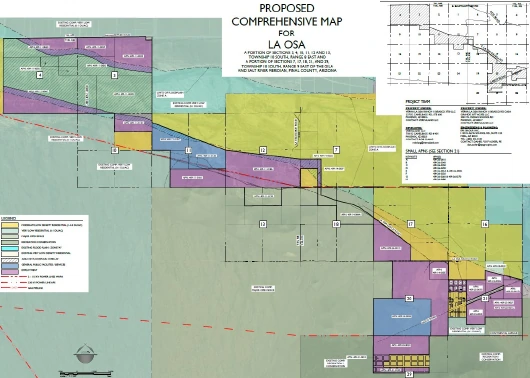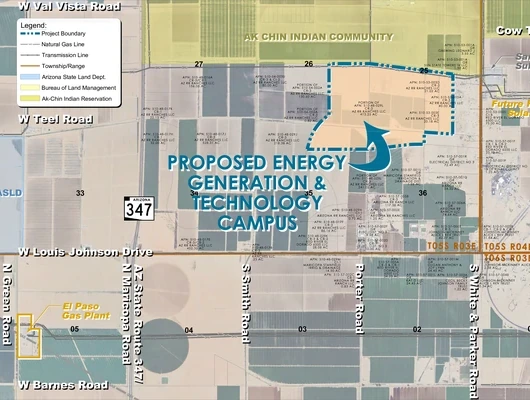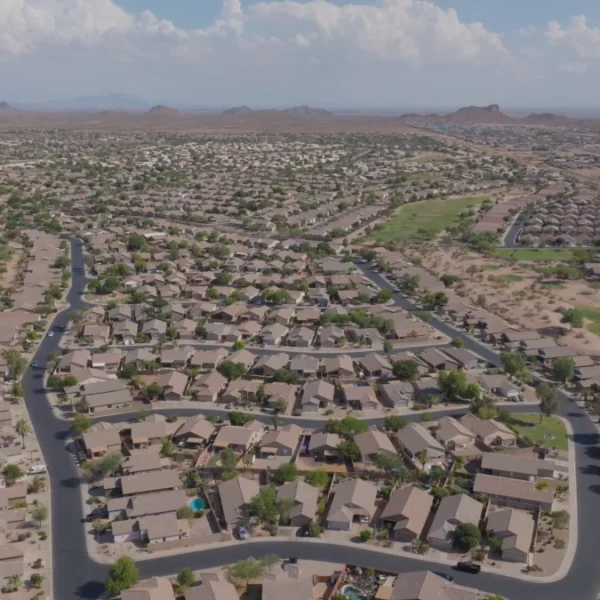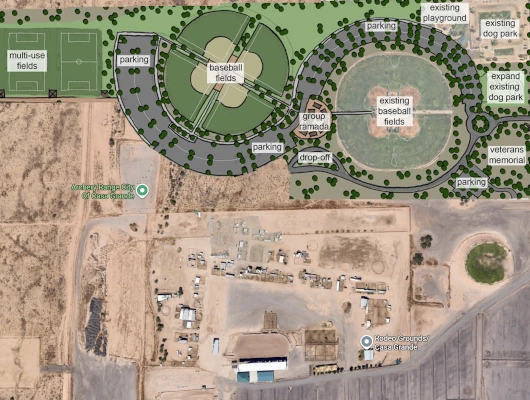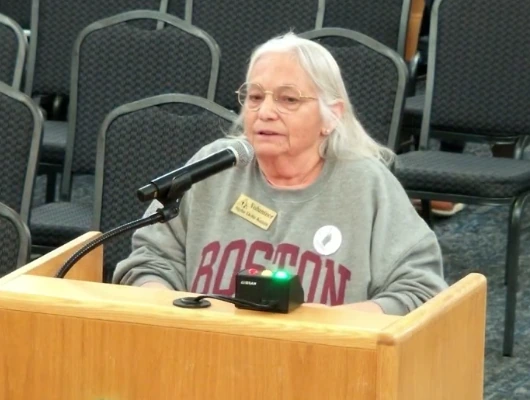The Pinal County Board of Supervisors voted unanimously to approve a comprehensive plan amendment for the La Osa Gas-Fired Power and Data Center Complex on November 19, 2025. The decision moves the massive approximately 3,374-acre project one step closer to reality.
This approval follows months of review detailed in Pinal Post’s previous coverage of the project. The project would transform rural land along the Greene Canal south of Eloy into a major energy and data infrastructure hub.
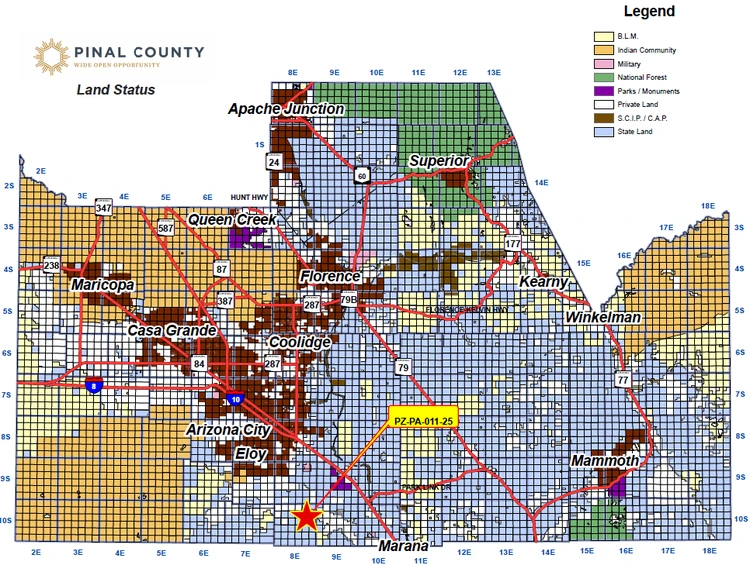
Voting Results and Planning Process
The Board of Supervisors approved the comprehensive plan amendment without stipulations. The project received approval recommendations earlier from both the Planning and Zoning Commission, which voted 7-3 in favor, and the Citizens Advisory Committee, which voted 11-4 to recommend approval.
The La Osa project was one of four energy and data center proposals approved by supervisors on November 19. The board also approved Project Midway (data center), Griffin Energy Project (solar, battery storage, gas-fired power), and the Energy Generation & Technology Campus (data center, battery storage) during the same meeting.
Chairman Stephen Miller emphasized the current stage of the process for all four projects. “To this project and to all these projects coming forward, we’re at the comprehensive plan level,” Miller said. “There’s years of engineering and planning before any of this stuff actually happens.”
Project Location and Layout
The La Osa Complex spans multiple parcels along the Greene Canal of the Santa Cruz Wash system. Senior Planner Sangeeta Deokar explained the property’s unusual configuration during her presentation.
The site “is kind of jagged, has multiple parcels, and the reason for that is the location along the Greene Wash of the Santa Cruz Wash,” Deokar said. “So basically, it ribbons along that wash.”
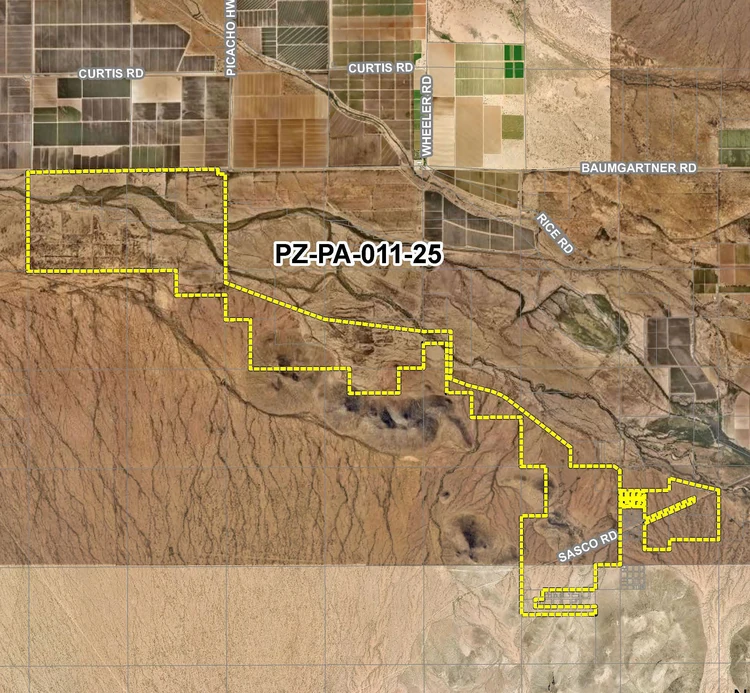
The comprehensive plan amendment designates approximately 1,910 acres for employment uses including data centers. Another 480 acres would support general public facilities and services including gas-fired power generation. The plan preserves approximately 983 acres as open space. The surrounding area consists primarily of state land, Bureau of Land Management property, and agricultural land.
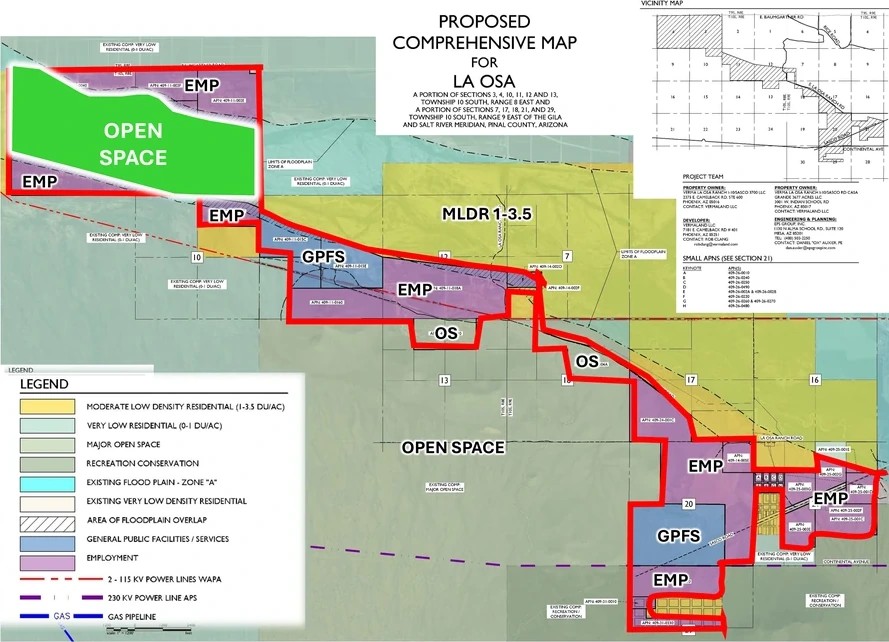
Power Generation Sets Project Apart
Unlike other data center proposals that have raised concerns about power availability, the La Osa project includes on-site power generation facilities. Court Rich from Rose Law Group, representing the applicant, highlighted this distinction.
“This is an energy project that’s gonna use the energy that they’re generating right there to create jobs,” Rich said. He noted the project has already begun working with Electrical District Number 4, which provided a letter of support.
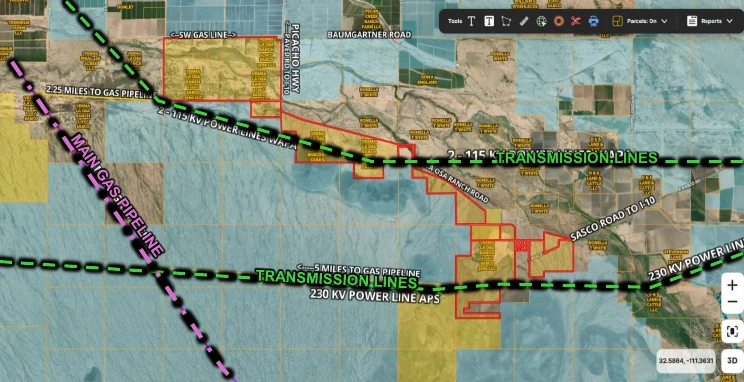
Vice Chairman Jeff McClure asked about the power generation structure, questioning whether the project could legally generate its own power. McClure noted that Arizona statute prevents companies from producing their own electricity due to historical lobbying by utility companies. “My understanding of statute is that these types of companies cannot actually make their own power,” McClure said. “Are we talking about generating on site, selling it to the electrical district, and then buying it back?”
Rich explained that Electrical District 4 would likely take possession of the energy and sell it to the data centers to comply with regulatory requirements. “We anticipate we’ll have ED4 taking possession of that energy and selling it to us to avoid some of those regulatory issues,” Rich said.
$20 Billion Investment and Tax Revenue
Rich described the project as an investment of nearly $20 billion, potentially more depending on the final site plan. “What that means is we are creating a tax-generating machine for the county,” Rich said. “Over 25 years, it’s gonna generate well over a billion dollars in tax revenue.”
Rich explained that data centers typically employ 100 to 140 people per facility, depending on the structure and operations.
“This is not manufacturing, I’ll submit to that, but it is a really, really big opportunity for job creation in the region,” Rich said.
Cepand Alizadeh from the Arizona Technology Council noted that for every job created at a data center, six additional jobs are created in the local economy. He cited entry-level positions that can pay $70,000 annually with full benefits.
No Water Cooling Commitment
Rich addressed water concerns directly. “This project will not be using water-cooled technology. I can’t say that loud enough,” he stated. The project will use either air-cooling or a closed-loop system instead.
Rich explained that when the project returns for zoning approval, the commitment will become a legally binding stipulation. “When that stipulation then goes into place on the approved zoning, that’s the law for this project,” he said.
Fire Safety and Noise Concerns
Vitiello raised questions about fire protection and noise from the gas-fired power plants. Arizona City Fire Chief Jeff Heaton addressed fire service plans during public comments.
Heaton explained that his district has been working with the Pinal County Attorney’s Office to create the Pinal County Fire and Medical Authority. This proposed agency would serve areas that currently lack fire and life safety services.
“The power plants really are the bolus that allows us to do it more aggressively, more quickly, and allows us to put more resources where resources currently aren’t there,” Heaton said.
Vitiello asked Rich about the location and funding for fire service. Rich confirmed the project would support the fire district financially. “When we’re back at the zoning time, we’ll certainly have all the details for you on that,” Rich said.
Regarding noise concerns, Rich explained that gas-fired power plants must go through an approval process at the Arizona Corporation Commission. This process requires noise studies and evaluations to ensure the technology meets standards.
Supervisor Mike Goodman referenced the SRP gas-generating plant in Gilbert, which operates near residential areas without noise complaints, as an example of how such facilities can coexist with communities.
Community Support and Opposition
Rich emphasized strong local support for the project. “The feedback we’ve received is the people in the area, the landowners that are next door want this project,” he said. “They see the opportunity for the region, they see the opportunity for Pinal County and the local area, and they’re inviting it into the neighborhood.”
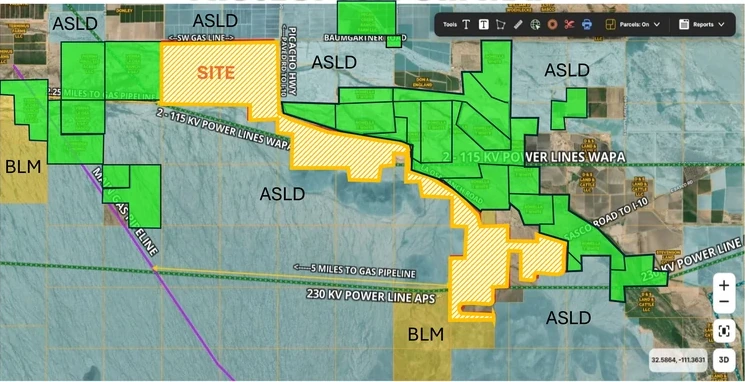
Staff received nine letters of support from immediate neighbors and 27 letters in opposition. Opposition letters cited concerns about impacts to the Ironwood Forest National Monument, desert ecology, wildlife habitat, water usage, potential increases in water and electric bills for residents, the ratio of jobs created versus desert land impacted, and Greene Wash pollution.
Public Comments
Tom Prezelski from Rural Arizona Engagement raised several concerns. He argued that new electrical infrastructure could lead to millions in costs passed on to consumers through higher utility rates. On water, Prezelski noted that Pinal County’s water situation is already strained, requiring special legislation to transfer water from agricultural to residential use. “If you’re gonna build a 3,000 acre facility, regardless of whether they’re air cooling it or not, that is going to severely tax those water resources even more,” he said. He added that cities like Phoenix, Mesa, and Tucson have been looking at ways to make data centers more responsible for their utility and water use. Mohave County, he noted, decided not to pursue data centers at all as part of their economic development planning.
Prezelski also questioned the long-term economic viability of data centers, noting recent news that investor Peter Thiel is pulling out of artificial intelligence investments. “There are doubts that this will be here, that there will be tenants for this data center in 10 or 20 years,” Prezelski said. “You’ll just have a 3,000-acre complex that is empty.”
Rich responded to utility cost concerns by noting that the project would build its own power plant. “This project is building its own power plant, so it will be paying for the cost to increase the electrical grid and generation needed for this project,” Rich said.
Supervisor Perspectives
Before the vote, supervisors shared their thoughts on the proposal.
Goodman emphasized his goal to reverse the trend of residents leaving Pinal County for work. “80 to 85% of our population was having to leave this area to go to work,” he said. “Projects like this will help establish what I’ve been elected to do.”
Goodman noted the project addresses concerns about data centers contributing to the grid. “They are adding to the grid because of the amount of power that you’re taking,” he said.
Timeline and Next Steps
The comprehensive plan approval represents the first phase of the development process. The project must return to the Board of Supervisors for zoning approval. This phase will include detailed engineering studies, environmental analysis, binding stipulations requiring non-water-cooled technology, and a fire service agreement with the Pinal County Fire and Medical Authority.
Required studies include hydrological analysis, geotechnical reports, and additional surveys. Improvements in the floodplain will require permits from Pinal County Public Works.
For additional background on the La Osa project including flood zone concerns, environmental impacts, project layout challenges, geological concerns, wildlife corridor testimony, landowner perspectives, and commissioner debates about project details, see Pinal Post’s earlier coverage from the July work session and the October Planning and Zoning Commission meeting.
